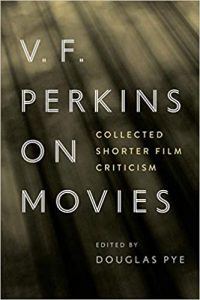In V.F. Perkins on Movies: Collected Shorter Film Criticism, editor Douglas Pye brings together a collection of writings by V. F. Perkins, a foundational figure in the history of film studies who developed one of the earliest film studies courses in the UK and wrote the core text Film as Film (1972). This excellent and essential new volume demonstrates Perkins’s career-long commitment to the questions of style and meaning in the interpretation of cinema, writes Tom Draper.
V.F. Perkins on Movies: Collected Shorter Film Criticism. Douglas Pye (ed.). Wayne State University Press. 2020.
Find this book (affiliate link): ![]()
 In April 1960, the student journal Oxford Opinion launched an attack on the British Film Institute (BFI) and its in-house film magazine Sight and Sound. ‘Film criticism in Britain is dead,’ wrote Ian Cameron in the journal’s editorial, sketching out what has now become a familiar declaration of existential crisis. ‘Indeed, it is sometimes difficult to believe that British criticism has ever been alive’ (25).
In April 1960, the student journal Oxford Opinion launched an attack on the British Film Institute (BFI) and its in-house film magazine Sight and Sound. ‘Film criticism in Britain is dead,’ wrote Ian Cameron in the journal’s editorial, sketching out what has now become a familiar declaration of existential crisis. ‘Indeed, it is sometimes difficult to believe that British criticism has ever been alive’ (25).
The issues at stake were not the financial constraints and declining print readerships threatening criticism today but questions of style and interpretation. ‘Nowhere is there the slightest sign of the detailed, academic criticism which one might reasonably expect to find in a publication of this sort and from this source,’ wrote the renowned film scholar V.F. Perkins (1936-2016) in a barbed assault on the BFI’s Fifty Famous Films, 1915-45 booklet. An art as new as cinema ‘demands intellect, perception, and sheer hard work to get to grips with aesthetic questions. And these are gifts which our critics too obviously lack. They are thus driven back to their easy assumption that a great film is made by the director’s having his heart in the right place. The assumption, like the booklet, and like the criticism that it so accurately mirrors, stinks’ (30).
Oxford Opinion’s youthful attack on the critical establishment of the day recalled that of Sequence magazine (1946-52), which began life as the journal of the Oxford University Film Society and whose contributors had also found Sight and Sound wanting. The Sequence impulse was driven by an interest in aesthetics (‘poetry’ was often used as a particularly strong form of praise), Hollywood films and melodrama, as well as an emphasis on the work of ‘film artists’, notably the director. Sight and Sound eventually absorbed many of the Sequence group, and critics such as Lindsay Anderson and Karel Reisz would later move into filmmaking and play a central role in the British New Wave. Dismayed by the decay of Sequence’s original promise into the Sight and Sound of the 1950s and 1960s, ‘the attitude which exalts right-mindedness above form, style and technique’ (30), Cameron and Perkins (alongside Mark Shivas and Paul Mayersberg) would later become the founding editors of Movie, a magazine dedicated to the close and detailed analysis of films, first published in 1962.
This excellent and essential new collection of V.F. Perkins’s shorter writing on film, published by Wayne State University Press and edited by Douglas Pye, opens with his bold rebellion against the old guard. But the hyperbole and commotion of Oxford Opinion and early Movie soon give way to the measured, detailed and insightful writing which would later distinguish Perkins as a significant figure in the history of film studies. Indeed, as the book progresses, the pieces become longer and more complex, with the most challenging and valuable work found in the latter two sections: ‘Film Criticism: Principles and Practice’ and ‘Directors and Movies’ (1981-2016), which incorporate work originally published in Movie, CineAction!, The Cine-Files and Film Quarterly as well as a few academic collections. What is remarkable to see unfold is the process by which the initial ideas of the preceding two sections (‘The British Cinema and British Film Criticism’ and ‘Developing a Detailed Criticism’ (1960-72)) are cultivated and refined in subsequent chapters. Perkins remained throughout his career single-minded in both his dedication to a handful of beloved filmmakers and to an approach which set out to integrate style and meaning in the analysis of movies.

Photo by Denise Jans on Unsplash
Movie’s project was not entirely uniform. Debate between writers existed (see the exchange of editorial disagreement in ‘Movie Differences: A Discussion’ in Movie no. 8, not included in this otherwise comprehensive volume, in which Perkins emerges as a critic of the European modernist cinema endorsed by others). What united Movie’s contributors though was an appreciation of the expressive use of style and mise-en-scène. In ‘The Cinema of Nicholas Ray’, first published in Movie no. 9, Perkins upholds ‘the extraordinary resonances which a director can provoke by his use of actors, decor, movement, color, shape – of all that can be seen and heard’ (163). This delight in filmic suggestion was coupled with an appeal to the spectator’s own critical faculties. ‘In order to enjoy [Otto] Preminger’s films the spectator must apply an unprejudiced intelligence,’ writes Perkins in ‘Why Preminger?’ ‘He is constantly required to examine the quality not only of the character’s decisions but also of his own reactions’ (113).
This emphasis on the democratic and egalitarian potential of mise-en-scène criticism has often been linked to Perkins’s own working-class background which ostensibly nurtured an ingrained distrust of authority and dogmatic pronouncement. Later, when he became an authority himself, Perkins would direct attention towards the films themselves, urging readers to internalise critical writing and ‘use it to enrich our contact with the film’ (255). ‘How much of what I say about Caught [Max Ophüls, 1949] is true and useful can be known only by checking against the film, particularly so as to see if you find that my description gives these moments valid meanings in their appropriate weights’ (254). Such an approach could explain Perkins’s legendary reputation as a teacher, first at Bulmershe College of Education, where he set up one of the earliest film studies courses in Britain, and later at the University of Warwick where he co-founded the Department of Film in 1978 (see this moving tribute from colleagues and former students).
In his masterwork and sole full-length book Film as Film (1972), Perkins advanced a ‘synthetic approach’ which valued works that integrated ‘how and what, content and form’ and the medium’s twin possibilities of realism and illusion. There unfolded the criteria which gave him most satisfaction in the cinema: balance, coherence, complexity, clarity, credibility, harmony, subtlety, the fusion of ‘narrative, concept and emotion’. This approach drew him towards a small sample of post-war Hollywood films, notably Rope (Alfred Hitchcock, 1948), Johnny Guitar (Nicholas Ray, 1954) and Carmen Jones (Otto Preminger, 1954), and away from the works of Sergei Eisenstein, Jean-Luc Godard and Michelangelo Antonioni which were enrapturing his peers. A privileging of the popular over the avant-garde as well as a ‘critical theory based so narrowly’ drew the ire of Sam Rohdie in the film journal Screen, but Perkins’s methods were never meant to be universal. As argued in the final chapter of Film as Film (‘The Limits of Criticism’), the degree to which Godard’s Les Carabiniers (1963) ‘is to be valued will have to be argued in terms other than those proposed here’.

Image Credit: Photo by Kilyan Sockalingum on Unsplash
Although ruffled by the denigration of Movie and Film as Film in Screen, Perkins would later take several other influential film critics and theorists to task. In ‘Film Authorship: The Premature Burial’, included in the collection’s third section, the inadequacies of Andrew Sarris’s auteur theory (a transformation of Cahiers du Cinéma’s famous ‘politique des auteurs’) and Peter Wollen’s ‘auteur structuralism’ are exposed. Perkins argues that their theories are defined by a ‘common feature’ and ‘crucial error’: ‘their exaggerated concern with the continuities and coherence across a body of work’ (220). The auteurist desire to elevate ‘recurring characteristics of style’ across a director’s career as a criterion of value shifted focus away from the single film towards the ‘dubious demand for coherence’ within a series (223). Worse still, for Perkins, was theorist and filmmaker Wollen’s preoccupation with binary oppositions and auteur structures laid out in a ‘scattering of inverted commas’: ‘Instead of confronting the problem of intention raised by the relation between the “auteur structure” and a director’s choices and designs, Wollen fell back an immaterial force with all the explanatory power of an ectoplasm’ (234).
David Bordwell’s Making Meaning: Inference and Rhetoric in the Interpretation of Cinema (1989) is given similar treatment in ‘Must We Say What They Mean?’ The belief that interpretation follows formal rules of inference, with ‘referential’, ‘explicit’, ‘implicit’ and ‘symptomatic’ meaning each available for detached discovery by the astute critic, has found Bordwell ‘under the spell of physics envy’. ‘Most often, the interesting meanings of films are not like this at all,’ writes Perkins. ‘They consist rather in attitudes, assessments, viewpoints – balances of judgment on the facts and behaviour portrayed’ (251). As in all of Perkins’s work, detailed analysis is used to bolster argument. Bordwell’s suggestion that the ‘point’ of The Wizard of Oz (Victor Fleming, 1939) can be found in its last line of dialogue, ‘There’s no place like home’, ‘involves a refusal to balance the affirmation in the words spoken by Dorothy Gale (Judy Garland) against the anxious entreaty in her tone and against other information that the film supplies: that the Kansas farmyard was indeed a place not remotely like home, a place lacking in courage, sensitivity, hope, and color, where the only singing that could be done was a lonely cry of yearning for something better’ (244).
Close readings of favoured films occupy the final section of V.F. Perkins on Movies. The bulk of these are devoted to the works of his most cherished filmmakers, Ophüls and Ray, and brilliantly evoke Perkins’s elucidation of ‘worldhood’ (from the outstanding essay ‘Where is the World? The Horizon of Events in Movie Fiction’ (270-300)). These masterly essays emerge from years of considered reflection and re-visitation. Ophüls’s Letter from an Unknown Woman (1948) (also discussed in ‘Moments of Choice’ and ‘Film Authorship’) is written about in three lengthy works. The first from 1981 focuses on the numerous patterns of contrasts within the film’s depiction of Linz and Vienna. Vienna is perceived as the handsome concert pianist Stefan’s world of freedom, but Linz is rigid, ‘trapped in pretense’, a site for a ‘preliminary confrontation between the strength of inner conviction and the power of social institutions’ (322). The distinctiveness of the Linz episode is also marked through style: Ophüls mutes ‘one of the film’s most marked visual effects: the presentation of Lisa’s [the ‘unknown woman’ infatuated with and disregarded by Stefan] face as a globe of radiance, lit from within (because from no material point in the film’s world) to shine in the surrounding darkness’ (318).
‘Letter from an Unknown Woman: On the Linz Sequence’ memorably compared the music of Vienna, which feeds a ‘fantasy of romance’, with the ‘band music, emphatically regulated by a conductor whose uniform is redolent of the official, the dutiful, and the public’ of Linz (319). This contrast was re-explored in ‘Ophuls Contra Wagner and Others’ (2000) following the revelation that ‘for Max Ophuls and screenwriter Howard Koch, working in 1947, the most immediate associations of Linz would have been with Adolf Hitler and the rise of Nazism’ (393). Perkins observes that the film sets the Wagner of Linz in opposition to Vienna’s Mozart. ‘For all the clarity with which the film exposes the complementary follies and blindnesses of its central pair, its moral preference is affirmed by placing both of them – pursued and pursuer alike – on the side of the scale marked “Mozart’’,’ Perkins writes (406).
This concern with returning to and rethinking earlier readings of films is taken up by ‘Omission and Oversight in Close Reading: The Final Moments of Frederick Wiseman’s High School’, the final essay Perkins published (2017). His intention here is to show how a single detail, hiding in plain sight, can challenge long-established interpretations. In this case, it is the view that the school is a ‘machine for producing subservience and conformity’ (479). By muting the sound of the film’s final image, Wiseman draws attention to the principal’s smile: ‘we have time to feel that the smile asserts a mood close to triumph […] The effect is the effect of a change, a loss, not just of an absence’ (485). Without demonising the school’s staff, ‘Wiseman is able to color our response to the principal and her claims within an overall viewpoint that can encompass complexity’ (489). Ultimately, then, this essay advocates looking closely and carefully and repeatedly, as Perkins did so brilliantly throughout his career. ‘When accurate analysis opens our eyes to new possibilities, or to new data that challenges our understanding, it is a future, better-informed encounter with the movie that we have in prospect […] The question will need to be addressed through lively interrogation of our renewed experience. In this process of introspection we shall, at our best, be alert for what we can truthfully say and mean’ (492-3).
Note: This review gives the views of the author, and not the position of the LSE Review of Books blog, or of the London School of Economics. The LSE RB blog may receive a small commission if you choose to make a purchase through the above Amazon affiliate link. This is entirely independent of the coverage of the book on LSE Review of Books.







